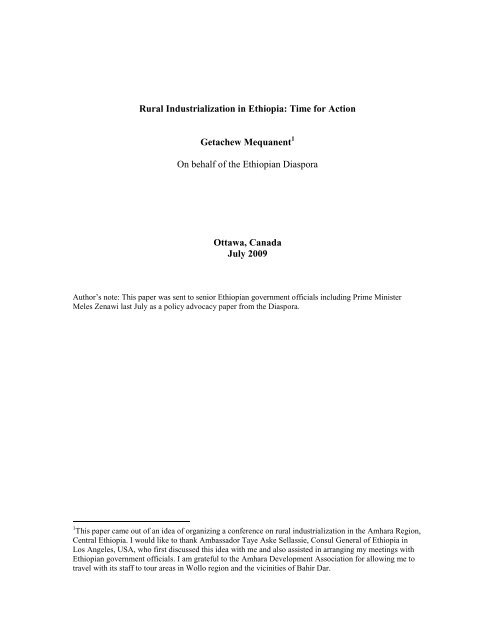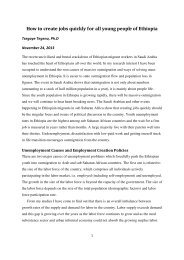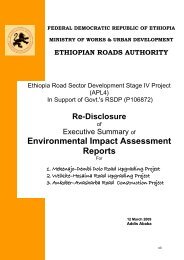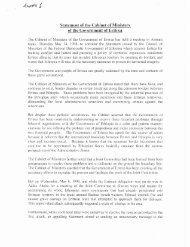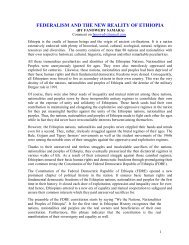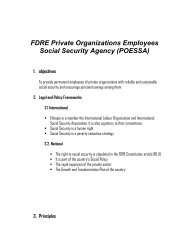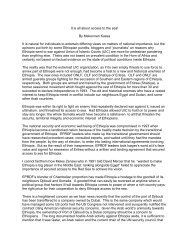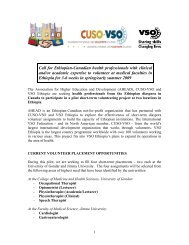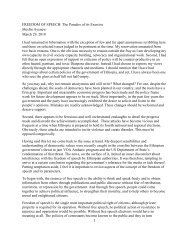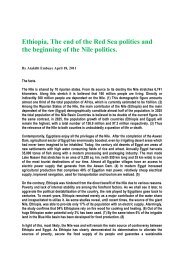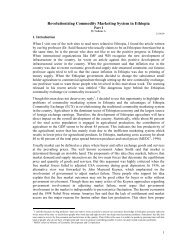Rural Industrialization in Ethiopia - Tecola Hagos
Rural Industrialization in Ethiopia - Tecola Hagos
Rural Industrialization in Ethiopia - Tecola Hagos
Create successful ePaper yourself
Turn your PDF publications into a flip-book with our unique Google optimized e-Paper software.
<strong>Rural</strong> <strong>Industrialization</strong> <strong>in</strong> <strong>Ethiopia</strong>: Time for ActionGetachew Mequanent 1On behalf of the <strong>Ethiopia</strong>n DiasporaOttawa, CanadaJuly 2009Author’s note: This paper was sent to senior <strong>Ethiopia</strong>n government officials <strong>in</strong>clud<strong>in</strong>g Prime M<strong>in</strong>isterMeles Zenawi last July as a policy advocacy paper from the Diaspora.1 This paper came out of an idea of organiz<strong>in</strong>g a conference on rural <strong>in</strong>dustrialization <strong>in</strong> the Amhara Region,Central <strong>Ethiopia</strong>. I would like to thank Ambassador Taye Aske Sellassie, Consul General of <strong>Ethiopia</strong> <strong>in</strong>Los Angeles, USA, who first discussed this idea with me and also assisted <strong>in</strong> arrang<strong>in</strong>g my meet<strong>in</strong>gs with<strong>Ethiopia</strong>n government officials. I am grateful to the Amhara Development Association for allow<strong>in</strong>g me totravel with its staff to tour areas <strong>in</strong> Wollo region and the vic<strong>in</strong>ities of Bahir Dar.
Table of ContentsTable of Contents………………………………………………………….1Executive Summary. ………………………………………..…………….21. Introduction……………………………………………………….…….42. The <strong>Ethiopia</strong>n Economy..…..………..…………………………………62.1 Modern Sector………………………………………………………82.1.1 Technological Capacity…………………………………………102.1.2 Skilled Workforce………………………………………………..112.2 Informal Sector..…………………………….……………..………113. Industrial Capability <strong>in</strong> <strong>Rural</strong> <strong>Ethiopia</strong>:Formative Conditions……..……..…………………………………….134. Towards Woreda (District) Industrial Plann<strong>in</strong>g ….……………………144.1. Two Steps of Plann<strong>in</strong>g……………………………………………..154.1.1 Project Feasibility Study………………………………………...154.1.2 Project Plann<strong>in</strong>g……………………………………………...….195. Conclusion……………………………………………………………..226. Annexes………………………………………………...………….…...23A. <strong>Rural</strong> <strong>Industrialization</strong> <strong>in</strong> Ch<strong>in</strong>a…………………..………………….26B. List of <strong>Ethiopia</strong>n Firms……………………………………………….27C. UN Industrial Classification System…………………………………321
Executive SummaryEighty-three perecent of <strong>Ethiopia</strong>ns live <strong>in</strong> rural areas still deriv<strong>in</strong>g their livelihoods fromsubsistence agriculture. The concentration of crop and livestock productions <strong>in</strong> thehighland areas, coupled with population growth and <strong>in</strong>appropriate land use, has resulted<strong>in</strong> the depletion of resource bases (land, water and vegetation). Despite the ga<strong>in</strong>s <strong>in</strong>agricultural production <strong>in</strong> recent years, <strong>Ethiopia</strong> still rema<strong>in</strong>s faced with the problem offood <strong>in</strong>security. The time has thus come to consider concerted efforts that support rural<strong>in</strong>dustrialization which would lead to a reduced reliance on subsistence agriculture as ama<strong>in</strong> source of livelihoods while transform<strong>in</strong>g the economy and promot<strong>in</strong>g long-termfood security.The <strong>Ethiopia</strong>n economy is (follow<strong>in</strong>g Walter Rostov’s theory 2 ) at its pre-take off stage ofgrowth as characterized by the expansion of education, health, electricity, <strong>in</strong>frastructure,f<strong>in</strong>ancial services and market facilities along with an <strong>in</strong>fant manufacture sector and theemergence of commercial class accumulat<strong>in</strong>g wealth and <strong>in</strong>vest<strong>in</strong>g <strong>in</strong> the economy. Thispre-take off growth will generate the dynamism essential for the expansion of theeconomy provided that there are cont<strong>in</strong>ued efforts to develop the country’s <strong>in</strong>dustrialcapability <strong>in</strong>clud<strong>in</strong>g technology and skilled workforce. More importantly, there shouldbe a clear vision and deliberate strategies to support the growth of rural-based <strong>in</strong>dustrieswhich can manufacture a variety of products like bricks, tiles, roof tops, furniture, textile,diary products, meat, fish, poultry, fruits and vegetables, beverages, lumber and wood,hides, soaps, detergent, wool, cloth and many other semi-f<strong>in</strong>ished and f<strong>in</strong>ished products.These <strong>in</strong>dustries would provide jobs for millions of rural <strong>Ethiopia</strong>ns and improvehousehold <strong>in</strong>come.Ch<strong>in</strong>a is an example of a country where rural <strong>in</strong>dustries drove economic growth and liftedhundreds of millions of people out of poverty. By 2004, these <strong>in</strong>dustries <strong>in</strong> rural townsand villages alone had employed 139 million people. The Ch<strong>in</strong>ese rural <strong>in</strong>dustrializationstrategy had many features <strong>in</strong>clud<strong>in</strong>g:Establish<strong>in</strong>g l<strong>in</strong>kages between <strong>in</strong>dustry and agriculture and promot<strong>in</strong>g theirdevelopment simultaneously;Transferr<strong>in</strong>g <strong>in</strong>dustrial plann<strong>in</strong>g responsibilities to local areas;Development of rural <strong>in</strong>dustrial capability (technology and skilled workforce);andEncourag<strong>in</strong>g local officials to play an entrepreneurial role <strong>in</strong> support of local<strong>in</strong>dustries.This paper then calls up on the <strong>Ethiopia</strong>n government to launch a program of rural<strong>in</strong>dustrialization that develops rural <strong>in</strong>dustrial capability <strong>in</strong>clud<strong>in</strong>g the follow<strong>in</strong>g<strong>in</strong>itiatives:2 The Stages of Economic Growth: A Non-Communist Manifesto, 1962.2
The creation of technical and organizational resources for Woreda governments,so that they can support rural <strong>in</strong>dustrial growth;Technological research and workforce tra<strong>in</strong><strong>in</strong>g tailored to the needs of rural<strong>in</strong>dustries;Initiatives that revive the <strong>in</strong>formal sector (consist<strong>in</strong>g of traditional <strong>in</strong>dustries andcommercial activities); andInitiatives that create rural-urban sectoral l<strong>in</strong>kages.To support the active role of government <strong>in</strong> rural <strong>in</strong>dustrialization, the paper presents onemethod of rural <strong>in</strong>dustrial plann<strong>in</strong>g at Woreda level. This method <strong>in</strong>cludes value cha<strong>in</strong>analysis, feasibility study and project plann<strong>in</strong>g.F<strong>in</strong>ally, it is recommended that:1) This paper be used as an <strong>in</strong>put to the discussion of the next national development plan(successor of PASDEP) <strong>in</strong> order to consider the formulation of multi-sector strategies <strong>in</strong>support of rural <strong>in</strong>dustrialization; and2) The rural <strong>in</strong>dustrial plann<strong>in</strong>g method presented <strong>in</strong> this paper be considered as model todesign an <strong>in</strong>dustrial plann<strong>in</strong>g tool <strong>in</strong>clud<strong>in</strong>g a tra<strong>in</strong><strong>in</strong>g program for Woreda, zonal,regional and federal government officials, so that they can support rural <strong>in</strong>dustrialgrowth.3
1. IntroductionThe <strong>Ethiopia</strong>n economy is dom<strong>in</strong>ated by subsistence agriculture consist<strong>in</strong>g of cropp<strong>in</strong>gand animal husbandry. Accord<strong>in</strong>g to one IMF report, <strong>in</strong> 2006/07, agriculture contributed46% of the country’s gross domestic product (GDP) and rema<strong>in</strong>ed the ma<strong>in</strong> source oflivelihoods for the majority of <strong>Ethiopia</strong>ns. 3 However, despite favourable governmentpolicies <strong>in</strong> the past decade, the agricultural sector has not provided a reliable source of<strong>in</strong>come for the population. The <strong>Ethiopia</strong>n government’s five-year (2005-2010) Plan forAccelerated and Susta<strong>in</strong>able Development to End Poverty (PASDEP) identifies thechallenges as the “lack and/or absence of more bus<strong>in</strong>ess/market-oriented agriculture;adverse climatic changes; failure to use agricutural land accord<strong>in</strong>g to appropriate land usemanagement plan and resource use; limitation <strong>in</strong> <strong>in</strong>formation base; lack of provision ofsupply and dissem<strong>in</strong>ation of appropriate technology; failure to <strong>in</strong>tegrate relevantactivities; and lack of adequate [agricultral program] implementation capacity”.The fact of the matter is that <strong>Ethiopia</strong>n agriculture has exhausted its carry<strong>in</strong>g capacity dueto land degradation and population growth. This means that agriculture can no longerprovide a reliable source of <strong>in</strong>come for the 63 million rural <strong>Ethiopia</strong>ns. Therefore, thetime has come to consider deliberate strategies that work towards the <strong>in</strong>dustrialization ofrural areas which would reduce reliance on subsistence agriculture while transform<strong>in</strong>g theeconomy and promot<strong>in</strong>g long-term food security. The <strong>Ethiopia</strong>n government shouldfacilitate the growth of labour <strong>in</strong>tensive rural <strong>in</strong>dustries that manufacture a variety ofproducts like bricks, tiles, light bulbs, roof tops, furniture, textile, diary products, meat,fish, poultry, fruits and vegetables, beverages, lumber and wood, hides, soaps, detergent,wool, cloth and many other semi-f<strong>in</strong>ished and f<strong>in</strong>ished products. These <strong>in</strong>dustries wouldprovide jobs for millions of rural <strong>Ethiopia</strong>ns and transform the economy.Broadly speak<strong>in</strong>g, <strong>in</strong>dustrialization is a process of transformation of an agricultural-basedeconomy to an <strong>in</strong>dustrial-based economy. In an <strong>in</strong>dustrial-based economy, home-basedproduction activities (farm<strong>in</strong>g, weav<strong>in</strong>g, carpenter<strong>in</strong>g, construction, blacksmith<strong>in</strong>g, etc.)are relocated to factories. Industrial mach<strong>in</strong>es operated by specially tra<strong>in</strong>ed workersreplace human and animal powered production technologies, which previously supportedhome-based production. Workers earn better wages and this improves their liv<strong>in</strong>gstandards. They also use their newly acquired economic power to demand better liv<strong>in</strong>gconditions and participation <strong>in</strong> the political process. Furthermore, unlike an agriculturalbasedeconomy, which can be vulnerable to the boom and bust of commodity markets, an<strong>in</strong>dustrial-based economy provides a stable source of susta<strong>in</strong>ed economic growth; theeconomy is diversified, so that a decl<strong>in</strong>e of one <strong>in</strong>dustry can be compensated by an<strong>in</strong>crease of market opportunities for another <strong>in</strong>dustry. The United Nations IndustrialDevelopment Organization (UNIDO) stresses that develop<strong>in</strong>g countries seriously3 The Federal Democratic Republic of <strong>Ethiopia</strong>: Selected Issues and Statistical Appendix, July 2008, Table1.4
consider the <strong>in</strong>dustrialization of their economies as a way out of perpetual problems ofeconomic <strong>in</strong>stability and poverty. 4The <strong>Ethiopia</strong>n government has adopted an agricultural led development <strong>in</strong>dustrialization(ALDI) strategy which cont<strong>in</strong>ues to serve as a framework of rural <strong>in</strong>vestment plann<strong>in</strong>g <strong>in</strong>the area of <strong>in</strong>frastructure, social services, research and extension. Hence, the currentPASDEP plan has aimed at achiev<strong>in</strong>g the expansion of health, education, electricity,market<strong>in</strong>g, roads and other facilities to rural areas (see Table 2. p. 13). The miss<strong>in</strong>gdimension <strong>in</strong> the ALDI strategy and PASDEP plan is lack of a clear vision and deliberatestrategies to speed up the growth of rural <strong>in</strong>dustries that utilize local resources tostimulate economic growth and meet the needs of society. While post-1991 governmentpolicies have created a good climate for <strong>in</strong>dustrial growth, this has rema<strong>in</strong>ed concentrated<strong>in</strong> urban areas without the benefits trickl<strong>in</strong>g down to rural society. It is thereforeimportant that <strong>Ethiopia</strong>n policy-makers move away from the “trickle-down” th<strong>in</strong>k<strong>in</strong>g ofeconomic growth that <strong>in</strong>dustries first grow <strong>in</strong> cities and gradually expand to rural areasthrough supply-demand l<strong>in</strong>kages or direct <strong>in</strong>vestment. This approach has been tried fordecades and did not work. Instead, the <strong>Ethiopia</strong>n government should enter thecountryside with a package of programs that deliver knowledge, know-how and resourcesto support the growth of <strong>in</strong>dustries which create employment and transform the economy.Ch<strong>in</strong>a is an example of a country where rural <strong>in</strong>dustries drove economic growth and liftedhundreds of millions of people out of poverty. Chris Dramall cites sources that <strong>in</strong>dicatethe employment, by 2004, of 139 million Ch<strong>in</strong>ese by rural town and village <strong>in</strong>dustriesalone. 5 The lessons from Ch<strong>in</strong>a are:1) Strong leadership. The Ch<strong>in</strong>ese Communist Party ensured that <strong>in</strong>dustries were l<strong>in</strong>kedto agriculture through the provision of direct support (<strong>in</strong>puts and services), and later <strong>in</strong>growth years (1980s and onwards), taxes and profits from <strong>in</strong>dustries were used to support<strong>in</strong>vestment projects that expanded rural <strong>in</strong>frastructure and services.2) Decentralized plann<strong>in</strong>g. Local governments played the lead<strong>in</strong>g role <strong>in</strong> <strong>in</strong>dustrialplann<strong>in</strong>g; they were expected to use their local knowledge to make appropriate<strong>in</strong>vestment and production decisions. In the post-Mao economic reform period, localgovernments assumed responsibilities for manag<strong>in</strong>g all state-owned enterprises.3) Moderniz<strong>in</strong>g traditional <strong>in</strong>dustries. These <strong>in</strong>dustries were scaled up by equipp<strong>in</strong>gthem with modern production technologies, new organizational models and provision ofmodern facilities like water and electricity.4) Persistence effort to achieve <strong>in</strong>dustrial self-reliance. By the 1960s, the Ch<strong>in</strong>ese hadalready started <strong>in</strong>tensify<strong>in</strong>g efforts to expand heavy <strong>in</strong>dustries <strong>in</strong> order to be able toproduce <strong>in</strong>dustrial mach<strong>in</strong>es and tools.4 Industrial Development Report 2009: Break<strong>in</strong>g In and Mov<strong>in</strong>g Up – New Industrial Countries for theBottom Billion and the Middle Income Countries, 2009.5 The <strong>Industrialization</strong> of <strong>Rural</strong> Ch<strong>in</strong>a, 2007.5
5) Government support. Different levels of government provided support to local<strong>in</strong>dustries <strong>in</strong> the form of f<strong>in</strong>ances, technical assistance, market<strong>in</strong>g and product design.6) Incentives. Cash bonuses were given out for cadres and local officials who madecollective enterprises profitable. Particularly, the cadres were play<strong>in</strong>g supportive roles forlocal <strong>in</strong>dustries by f<strong>in</strong>d<strong>in</strong>g markets and promot<strong>in</strong>g local products (just as sales peoplewould do).These lessons are further elaborated <strong>in</strong> accompany<strong>in</strong>g background material on Ch<strong>in</strong>awhich can be found <strong>in</strong> Annex A. Suffice to say here that there should be no one-size-fitsalldevelopment strategy. <strong>Ethiopia</strong> is unique and different from Ch<strong>in</strong>a <strong>in</strong> terms of history,geography, population, culture, resource endowments, socio-economic realities and otherfactors. The Ch<strong>in</strong>ese experience is mentioned here to show that rural <strong>in</strong>dustrialization issometh<strong>in</strong>g that can be conceptualized and planned with government leadership. And thereason to do this <strong>in</strong> <strong>Ethiopia</strong> is obvious. Given the exhaustion of carry<strong>in</strong>g capacity of<strong>Ethiopia</strong>n agriculture, local <strong>in</strong>dustries must be grown to create employment for therapidly grow<strong>in</strong>g rural population. As rural areas lack technology, know-how, capital,<strong>in</strong>stitutions and other resources necessary to <strong>in</strong>duce <strong>in</strong>dustrial growth, the <strong>Ethiopia</strong>ngovernment must fill this gap by provid<strong>in</strong>g technical, f<strong>in</strong>ancial and organizationalassistances.While there is a grow<strong>in</strong>g body of literature on politics, macroeconomic policy,<strong>in</strong>ternational relations (<strong>in</strong>clud<strong>in</strong>g foreign aid), land, environment and other subject areasof concern, little attention has been paid to the <strong>Ethiopia</strong>n <strong>in</strong>dustrial sector <strong>in</strong> relation to itssize, diversity, productivity capacity, growth strategies and other structural factors. Norhas there been any th<strong>in</strong>k<strong>in</strong>g beyond the usual rhetoric of “off-farm employment” and“agri-bus<strong>in</strong>ess” to conceive the idea of rural <strong>in</strong>dustrialization as a viable solution topoverty. This paper thus contributes to theoretical and practical understand<strong>in</strong>gs of why<strong>in</strong>dustries are important <strong>in</strong> the <strong>Ethiopia</strong>n economy and national life and what can be doneto support their growth <strong>in</strong> rural areas. The next section provides a brief overview of the<strong>Ethiopia</strong>n economy <strong>in</strong>clud<strong>in</strong>g the challenges and opportunities of <strong>in</strong>dustrial growth andexpansion. Section three assesses how current government efforts can create theconditions for rural <strong>in</strong>dustrialization by diffus<strong>in</strong>g knowledge, know-how and<strong>in</strong>frastructures to rural areas. Section four presents one method of rural <strong>in</strong>dustrialplann<strong>in</strong>g that enhances the capacity of the <strong>Ethiopia</strong>n government at Woreda level toidentify, plan and support local entrepreneurial <strong>in</strong>itiatives. The last section concludes byrepeat<strong>in</strong>g the call for the development of a program of rural <strong>in</strong>dustrialization and mak<strong>in</strong>grecommendations. S<strong>in</strong>ce the target audience is government officials, the paper is moredescriptive and explanatory and not concerned with academic argument and analyses ofhistorical and contemporary debates.2. The <strong>Ethiopia</strong>n EconomyThere is now a large body of literature <strong>in</strong> the field of economic development andreview<strong>in</strong>g it is beyond the scope of this paper. However, we can still consider twoorig<strong>in</strong>al thoughts as a way of sett<strong>in</strong>g the context for this discussion. The first is ArthurLewis’ two-sector economy model that identifies a develop<strong>in</strong>g country economy6
consist<strong>in</strong>g of a modern <strong>in</strong>dustrial sector and an agricultural sector. 6 Lewis came up withthis model <strong>in</strong> order to argue that agriculture should facilitate <strong>in</strong>dustrial growth byprovid<strong>in</strong>g raw materials and unlimited supply of surplus labour. In turn, the absorption ofsurplus labour by <strong>in</strong>dustries would <strong>in</strong>crease the marg<strong>in</strong>al productivity of labour <strong>in</strong>agriculture. For example, if land hold<strong>in</strong>g size had been l hectare/household prior to theavailability of <strong>in</strong>dustrial employment, this could gradually rise to 2 hectare/household,because there are now fewer people left to work on the farm. This would <strong>in</strong>creaseproductivity <strong>in</strong> agriculture and also improve household <strong>in</strong>come.Lewis’ model has been criticized on many grounds 7 . For <strong>in</strong>stance, agriculture should besupported to develop itself, <strong>in</strong>stead of relegat<strong>in</strong>g its role to support<strong>in</strong>g <strong>in</strong>dustrial growth.The marg<strong>in</strong>al productivity of agricultural labour could be greater <strong>in</strong> pick agriculturalseasons (this means no surplus labour). For example, <strong>Ethiopia</strong>n farmers compla<strong>in</strong>edabout labour shortages dur<strong>in</strong>g the harvest<strong>in</strong>g season, because all the children were go<strong>in</strong>gto school; local officials talked about the idea of clos<strong>in</strong>g schools for two weeks, so thatchildren could help their parents. 8 Yet, Lewis’ theory can still be relevant <strong>in</strong> the study ofa country like <strong>Ethiopia</strong> where agriculture and <strong>in</strong>dustry exist side by side. His two-sectoreconomy analytical model can also help to look beyond modern <strong>in</strong>dustries to recognizethe needs of traditional <strong>in</strong>dustries or known as <strong>in</strong>formal sector firms.Another earlier th<strong>in</strong>ker Walter Rostov <strong>in</strong>troduced a model that identified five stages ofeconomic growth. 9 The first stage is characterized by an agrarian economy dom<strong>in</strong>ated bysubsistent agriculture with little awareness of modern science and technologies. Thepreconditions of economic take off (second stage) are created when modern services(education, health, bank<strong>in</strong>g, etc.) and <strong>in</strong>frastructures are expanded along with a fewmanufacture <strong>in</strong>dustries and the emergence of a property class which beg<strong>in</strong>s to accumulatewealth and <strong>in</strong>vest <strong>in</strong> the economy. At the third stage, primary (m<strong>in</strong><strong>in</strong>g), secondary(<strong>in</strong>dustry) and tertiary (service) sectors lead economic growth. The economy takes offand this completes the transition from an agrarian economy to a modern <strong>in</strong>dustrialeconomy. The fourth stage is the time of “drive to maturity” whereby the economydiversifies and <strong>in</strong>come trickles down to society to alleviate poverty. The fifth stage is theage of high mass consumption, which is an advanced <strong>in</strong>dustrial era.Rostov also has critics who (for example) po<strong>in</strong>ted out that his “growth stage” theory wassolely based on the American history of development and so it fails to consider othernon-capitalist models of development, such as that of Ch<strong>in</strong>a or Russia. 10 In spite of this,many analysts and <strong>in</strong>ternational agencies <strong>in</strong>clud<strong>in</strong>g the United Nations use someth<strong>in</strong>gsimilar to Rostov’s model to divide the countries of the world <strong>in</strong>to groups of least<strong>in</strong>dustrialized countries, middle <strong>in</strong>come countries and advanced <strong>in</strong>dustrialized countries.6 “Economic development with unlimited supplies of labour” Manchester School, 22, 1954, pp. 139-91.7 For these and other criticisms see Ghatak Suberata and Ken Ingersent (1984). Agriculture and EconomicDevelopment. Harvester press, Sussex.8 Personal communications <strong>in</strong> the Amhara region, November 2008.9 Ibd.10 See comment on http://en.wikipedia.org/wiki/Rostovian_take-off_model#cite_note-0, February 15, 2009.7
We apply Arthur Lewis’ theory here to look at the <strong>Ethiopia</strong>n economy <strong>in</strong> the context of atwo-sector economy consist<strong>in</strong>g of the modern <strong>in</strong>dustrial sector and traditional/<strong>in</strong>formalsector. We also apply Walter Rostov’s growth theory to state that the <strong>Ethiopia</strong>n economyis at its pre-take off (second) stage of growth and will achieve the take off (third) stage <strong>in</strong>two decades provided that the <strong>Ethiopia</strong>n government <strong>in</strong>tensifies efforts that develop thecountry’s <strong>in</strong>dustrial capability <strong>in</strong>clud<strong>in</strong>g technology and skilled workforce. In whatfollows, we provide overviews of both the modern and <strong>in</strong>formal sectors of <strong>Ethiopia</strong>neconomy as well as broadly identify challenges and opportunities of growth andexpansion <strong>in</strong> these two sectors.2.1 Modern Sector. The<strong>in</strong>formation <strong>in</strong> Table 1 wasobta<strong>in</strong>ed onl<strong>in</strong>e from a SouthAfrican-based Mbendi InformationServices which claims to have250,000 web site visitors andnewsletter readership of nearly100,000 a month, with 46%African audience. The Tableidentifies 188 firms which arearbitrarily grouped us<strong>in</strong>g thestandard classification of moderneconomy <strong>in</strong>to primary, secondaryand tertiary sectors (a complete listof these firms can be found <strong>in</strong>Annex B). Yet, it is difficult toverify whether the <strong>in</strong>formation isderived from a reliable data us<strong>in</strong>g acomprehensive list of specificfirms or a representative sample ofall firms <strong>in</strong> <strong>Ethiopia</strong>. Nonetheless,tak<strong>in</strong>g these 188 firms as anexample, we will be able to getsome idea of the size and diversityTable 1 11Sector 188 firms 100%1. Primary 31 16.5%Agriculture 6 3.2%M<strong>in</strong><strong>in</strong>g 14 7.4%Oil and Gas 11 5.8%2. Secondary 63 33.5%Manufactur<strong>in</strong>g 50 26.6%Chemicals 4 2.1%Construction, equipmentand eng<strong>in</strong>eer<strong>in</strong>g 3 1.6%Automotive 4 2.1%Public utilities 2 1.0%3. Tertiary (service) 94 50.0%Chamber of commerce 1 0.5%F<strong>in</strong>ancial services 12 6.4%Professional services 5 2.6%Transport and storage 10 5.3%Trad<strong>in</strong>g 21 11.2%Wholesale and Retail 11 5.8%Real estate 2 1.0%Computers and9 4.8%communicationTravel, tourism andrecreation 9 4.8%of the <strong>Ethiopia</strong>n modern sector. Hence, for <strong>in</strong>stance, m<strong>in</strong><strong>in</strong>g, oil and gas, manufactur<strong>in</strong>g,transport, trade, retail<strong>in</strong>g and communications <strong>in</strong>dustries dom<strong>in</strong>ate the <strong>Ethiopia</strong>n modernsector. The list of firms <strong>in</strong> Annex B also shows that manufactur<strong>in</strong>g firms are large anddiverse with most of them concentrated <strong>in</strong> the food and beverage production sector. Otherthan resource-based <strong>in</strong>dustries (agriculture, m<strong>in</strong><strong>in</strong>g, oil and gas), normally <strong>in</strong>dustrialproductions are concentrated <strong>in</strong> urban areas.These and a large number of other <strong>in</strong>dustrial firms play a critical role <strong>in</strong> the ma<strong>in</strong>tenanceof the <strong>Ethiopia</strong>n economy and national life as producers, suppliers, distributors,11 Mbendi Information Services, http://www.mbendi.com/land/af/et/p0005.htm, retrieved January 31, 2009.8
exporters, importers and consumers of services and goods. To illustrate this po<strong>in</strong>t, wehave presented <strong>in</strong> Box 1 a list of 30 manufactured goods that could be found <strong>in</strong> andaround a modest modern <strong>Ethiopia</strong>n household. These goods could have hundreds of local,national and global orig<strong>in</strong>s or they have created value cha<strong>in</strong>s <strong>in</strong>volv<strong>in</strong>g hundreds of firmsthat produce raw materials and semi-f<strong>in</strong>ished and f<strong>in</strong>ished goods. For example, themanufacturer obta<strong>in</strong>ed spare parts from Taiwan to assemble the DVD player. To makethe bicycle, the local bicycle shop got steelfrom a metallurgical company and theBox 1. Household Productsspare parts from a parts company. To1. Cook<strong>in</strong>g pot 16. Fridgemake the table, the manufacturer got2. Stove 17. Televisionlumber from a lumber company, nail,3. Tables 18. DVD playerhammer, glue, etc, from a parts company, 4. Chairs 19. TVpa<strong>in</strong>t from chemical company, the5. Bicycle 20. Sugarbuild<strong>in</strong>g (rent) from a real estate company, 6. Knives 21 Toothpasteelectricity and water from a utility7. Cups 22. Toilet papercompany, and truck (to transport the table) 8. Glasses 23. Facial issuefrom a transportation company. To build 9. Sofa 24. Cupboardthe house, the contractor imported heavy 10. Bed 25. Shoeslift<strong>in</strong>g equipment and tools from Italy and 11. Matches 26. Buttonsalso got the service of a local consultant to 12. Needles 27. Light bulbs13. W<strong>in</strong>dows 28. Doorsensure conformity with government14. Mattress 29. Rooftopsconstruction guidel<strong>in</strong>es. In fact, the 18815. Cement 30. Bricksfirms identified <strong>in</strong> Table 1 above could bepart of value cha<strong>in</strong>s <strong>in</strong> the production of many of the household goods listed <strong>in</strong> Box 1.On the basis of the examples presented <strong>in</strong> Table 1 and Box 1, we can hypothesize theexistence of two gaps <strong>in</strong> the <strong>Ethiopia</strong>n economy. First, as a country of 75 million people,<strong>Ethiopia</strong> has no sufficient <strong>in</strong>dustrial capacity to produce goods and services necessary toma<strong>in</strong>ta<strong>in</strong> a modern economy and way of life. This means that the country must cont<strong>in</strong>ueto import and encounter the problem of trade deficit estimated to reach US $7.5 billion <strong>in</strong>2009/10 and <strong>in</strong>creas<strong>in</strong>g to US $11.5 billion by 2014/15. 12 Second, the capital goods(equipment, tools, spare parts, etc.) production <strong>in</strong>dustry is <strong>in</strong> its very <strong>in</strong>fancy. As theexample <strong>in</strong> Table 1 shows, heavy <strong>in</strong>dustry firms (construction, equipment andeng<strong>in</strong>eer<strong>in</strong>g) represent only 1.6% of the 188 firms, which can be a clear <strong>in</strong>dication of<strong>Ethiopia</strong>’s bottleneck <strong>in</strong> the production of <strong>in</strong>dustrial mach<strong>in</strong>es, tools and other capitalgoods necessary for speed<strong>in</strong>g up the process of <strong>in</strong>dustrialization. Clearly, then, theproduction of consumption and capital goods domestically has many benefits for<strong>Ethiopia</strong>ns <strong>in</strong>clud<strong>in</strong>g low prices (e.g. stoves and fridges will be cheaper), job creation,foreign currency sav<strong>in</strong>gs and the structural transformation of economy. But, all this canbe easier said than done. <strong>Ethiopia</strong> has to develop technological capacity and produce askilled <strong>in</strong>dustrial workforce necessary to drive the growth and expansion of <strong>in</strong>dustrialproduction.12 IMF. Ibd. 2008.9
<strong>in</strong> primary education at national level and construction of 13 additional higher education<strong>in</strong>stitutions that offer degree programs (see Table 2, p. 13). Hence, the World Bank saysthat (as of December 2008) there were 15 million students enrolled <strong>in</strong> primary andsecondary schools and, <strong>in</strong> 2007, 203,000 students were tak<strong>in</strong>g higher education. 14 Thesegraduates would def<strong>in</strong>itely br<strong>in</strong>g badly needed knowledge and skills to the <strong>Ethiopia</strong>nlabour market. However, <strong>Ethiopia</strong> should also diversify skill-tra<strong>in</strong><strong>in</strong>g programs to thetune of growth and expansion of the whole economy. For example, if we consider the<strong>in</strong>dustrial classification system of the United Nations (see Annex C), the manufacturesector alone consists of 26 different <strong>in</strong>dustries rang<strong>in</strong>g from food and beverage, plastic,textiles, paper, and wood products to metal, electronics, vehicles, chemicals andequipment productions. All these <strong>in</strong>dustries require specific skills and knowledge tooperate equipments, manage <strong>in</strong>ventories and ma<strong>in</strong>ta<strong>in</strong> facilities, as well as highlyspecialized skills <strong>in</strong> research and development of products. Unless there are proactiveapproaches, <strong>Ethiopia</strong> may lose growth opportunities from new <strong>in</strong>dustries, as it takes timeto design curricula and tra<strong>in</strong> workers for these <strong>in</strong>dustries.Of course, higher education is not the only way to acquire <strong>in</strong>dustrial skills. The traditionalsystem of apprenticeships, where people are tra<strong>in</strong>ed on the job, is the quickest way oflearn<strong>in</strong>g. The government can give <strong>in</strong>centives for firms, such as wage subsidy, toencourage them to create apprenticeship opportunities for young elementary and highschool graduates.2.2 The Informal Sector. If you go out to an open gebya (market) <strong>in</strong> a small <strong>Ethiopia</strong>nrural town or village, you will f<strong>in</strong>d different entrepreneurs sell<strong>in</strong>g and buy<strong>in</strong>g a variety ofgoods and services. Don’t forget that the men who sell agricultural tools and furniture orthe women who sell cook<strong>in</strong>g clay-pots and beauty products (for example) are also themanufacturers of those products. These entrepreneurs then constitute what is oftenreferred as the <strong>in</strong>formal or traditional sector. Although this sector is large and diverse, wehave arbitrarily identified three types of ma<strong>in</strong> activities below: 15Seasonal Activities: Seasonal activities concentrate on trade and they are more <strong>in</strong>tensedur<strong>in</strong>g the harvest<strong>in</strong>g season. Examples are buy<strong>in</strong>g and resell<strong>in</strong>g coffee, fruits,vegetables, eggs and food crops locally. Traders travel to the countryside to buy productsdirectly from producers (with lower prices), or they compete with a large number ofconsumers <strong>in</strong> the open market (gebya). Some resell the products <strong>in</strong> the local area with ameagre of profit, while others take risks (high cost of transportation and storageproblems) to go to distant places to make good profit. Traders <strong>in</strong> food crops are often ableto tap opportunities <strong>in</strong> distant markets, s<strong>in</strong>ce they are very likely to have better means ofmobiliz<strong>in</strong>g <strong>in</strong>formation and transportation.14 World Bank. <strong>Ethiopia</strong>: Sixteen Million Students to Benefit from World Bank Credit to Improve theQuality of General Education. Press Release No: 2008/176/AFR,http://web.worldbank.org/WBSITE/EXTERNAL/NEWS/0,,contentMDK:22013088~menuPK:34463~pagePK:34370~piPK:34424~theSitePK:4607,00.html, retrieved January 10, 2009.15 This description ma<strong>in</strong>ly draws from the author’s experience <strong>in</strong> Gondar, Northern <strong>Ethiopia</strong>.11
Perennial Activities. Perennial (occupational) activities <strong>in</strong>clude retail trade,blacksmith<strong>in</strong>g, pottery, carpentry, construction, hairdress<strong>in</strong>g, firewood and charcoalproduction, mechanics, repairs, shoe mak<strong>in</strong>g, tailor<strong>in</strong>g, food and beverage cater<strong>in</strong>g andmany other entrepreneurial activities. Many of such activities are directly or <strong>in</strong>directlyl<strong>in</strong>ked to the modern sector to obta<strong>in</strong> commodities like spare parts, sugar, cloth, shoes,school material and medic<strong>in</strong>e. Perennial entrepreneurs are more likely to have betterfacilities and permanent premises.Diversified Activities. This means comb<strong>in</strong><strong>in</strong>g two, three or more activities to earndescent livelihoods. For <strong>in</strong>stance, the author knew a young man who ran a kiosk (smallretail shop), repaired watches and radios and hired a young woman to sell food, tea andsoft dr<strong>in</strong>k - all of the work done at the same premise. In another <strong>in</strong>stance, three sistersdivided their tasks as follows: one of them traded fruits and vegetables, while the othersold korefe (local soft-beer) and the third sister ran a kiosk. In good times, such activitieshelp to <strong>in</strong>crease the level of household <strong>in</strong>come. In bad times, they help to create differentsurvival strategies; for example, if one of the sisters <strong>in</strong> the example above does not makeenough money, the other two would have earned enough to meet the basic needs of thefamily.The build<strong>in</strong>g of capacity of the <strong>in</strong>formal sector to take up new technologies andorganizational models will be the first crucial step towards stimulat<strong>in</strong>g <strong>in</strong>dustrial growth<strong>in</strong> rural <strong>Ethiopia</strong>. Be that as it may, it is also important to critically analyze the growthpotential of these diverse <strong>in</strong>formal sector activities and consider those that are viable (<strong>in</strong>terms of <strong>in</strong>novation, competition and growth) <strong>in</strong> <strong>in</strong>dustrial plann<strong>in</strong>g processes asproducers, suppliers, distributors, retailers, consumers, and so on (see section four).While one appreciates many of the characteristics of <strong>in</strong>formal sector activities (e.g. selfreliance,flexibility, needs oriented and rural centred), it may also be true that not all ofthem have the capacity to <strong>in</strong>novate and grow. As an example, one documentary by the<strong>Ethiopia</strong>n Television sometime ago found that some of the beneficiary of micro f<strong>in</strong>anceprograms had little or no bus<strong>in</strong>ess experience and that, <strong>in</strong> one <strong>in</strong>stance, a group of youngpeople simply ended up sett<strong>in</strong>g up photocopy shops on the same street block to competewith each other for customers. Some of those shops might not have survived. Thebus<strong>in</strong>ess proposals for those photocopy shops should have been carefully evaluatedbefore mak<strong>in</strong>g the decision to f<strong>in</strong>ance them.In sum, this section has provided broad <strong>in</strong>sights of the size and diversity of the <strong>Ethiopia</strong>neconomy <strong>in</strong>clud<strong>in</strong>g the constra<strong>in</strong>ts and opportunities of growth and expansion. Perhapsone of the <strong>in</strong>terest<strong>in</strong>g aspects of our discussion here is to learn the importance of the<strong>in</strong>formal sector <strong>in</strong> terms of its role as a ma<strong>in</strong> source of employment for millions of<strong>Ethiopia</strong>ns and its potential as an “<strong>in</strong>terim structure” of government <strong>in</strong>tervention to fosterand promote rural economic growth. Many of the Ch<strong>in</strong>ese rural <strong>in</strong>dustries that have beencredited for economic take off <strong>in</strong> the countryside were rooted <strong>in</strong> traditional <strong>in</strong>dustries thatwere scaled up by equipp<strong>in</strong>g them with modern production technologies, neworganizational models and provision of modern facilities like water and electricity. Aswe illustrate <strong>in</strong> section four, all this understand<strong>in</strong>g will be important <strong>in</strong> the conceptionand articulation of rural <strong>in</strong>dustrialization <strong>in</strong>itiatives.12
3. Industrial Capability <strong>in</strong> <strong>Rural</strong> <strong>Ethiopia</strong>: Formative ConditionsOne of the th<strong>in</strong>kers of the 1960s T.W. Shultz wrote that the problem of rural development<strong>in</strong> develop<strong>in</strong>g countries was simply an “<strong>in</strong>vestment problem ” <strong>in</strong> <strong>in</strong>frastructure, services,research and technology. He said that, if farmers were given opportunities, they would“turn sand <strong>in</strong>to gold ”. 16 Indeed, the Ch<strong>in</strong>ese experience shows that farmers wouldrespond to emerg<strong>in</strong>g opportunities (see Annex A). In what follows, we assess how<strong>Ethiopia</strong>n government sectoral <strong>in</strong>itiatives can diffuse knowledge, skills and<strong>in</strong>frastructures to create the conditions for rural <strong>in</strong>dustrialization. These <strong>in</strong>itiatives arereflected <strong>in</strong> Table 2 as highlights of results from the five-year (2005-2010) PASDEPplan. Hence:1) Electrification of rural areas canencourage the mechanization oftraditional rural <strong>in</strong>dustries (weav<strong>in</strong>g,carpenter<strong>in</strong>g, black smith<strong>in</strong>g,mill<strong>in</strong>g, construction, etc), attractoutside capital, extend the hours ofbus<strong>in</strong>ess operation (<strong>in</strong>creas<strong>in</strong>gproductivity), create better storagefacilities, and change the way ruralpeople live, especially by enabl<strong>in</strong>gthem to use modern appliances (e.g.cook<strong>in</strong>g and storage) and connect<strong>in</strong>gthem to the modern world (radio andTVs).2) Technical support and advice tofarmers can lead to <strong>in</strong>creasedawareness of science andtechnology.3) <strong>Rural</strong> education can lead tooccupational diversification (e.g.repair<strong>in</strong>g production equipments,appliances and electrical wir<strong>in</strong>g).Many elementary and high schoolgraduates can enter the <strong>in</strong>formalsector with skills and knowledge to<strong>in</strong>troduce new technologies and organizational models.Table 2. Highlights of PASDEP Sector ResultsEnergy. Increased power generat<strong>in</strong>g capacity to 2,218MW from 791 MW; construction of 11 electric powerstations and 13,000 km transmission grids; and 420rural electrification service cooperatives.Tra<strong>in</strong><strong>in</strong>g. 25 Tra<strong>in</strong><strong>in</strong>g and Vocational Educationcentres established; 55,000 extension workers tra<strong>in</strong>ed;18,000 Farmer Tra<strong>in</strong><strong>in</strong>g Centres established; 10 millionpeople to receive tra<strong>in</strong><strong>in</strong>g.Education. 86% coverage <strong>in</strong> primary education atnational level.Higher education. Construction of 13 additionalhigher education <strong>in</strong>stitutions that offer degreeprograms, <strong>in</strong>creas<strong>in</strong>g overall annual university <strong>in</strong>taketo 150,000.Health. Achieve “low-level health facilities with<strong>in</strong> 10km for almost all of the population”; and constructionof 94,000 wells and boreholes and development of13,000 spr<strong>in</strong>gs.Market<strong>in</strong>g. 70% of rural people organized undercooperatives; 108 warehouse, storage, abbators andother facilities constructed; and 10 agriculturalcommodity exchange centres opened.Communication. Reduced average walk<strong>in</strong>g distancefrom a road to 3.2 hours; 7 millions telephone l<strong>in</strong>es(fixed and mobile) and 100% access with<strong>in</strong> 5 km; and<strong>in</strong>crease ITC services.Resource mapp<strong>in</strong>g. Increased geological survey tomap resource potentials across the country.4) Cooperatives and other market agencies can help to improve distribution and storagefacilities, attract outside <strong>in</strong>vestment and <strong>in</strong>crease rural-urban l<strong>in</strong>kages.16 Transform<strong>in</strong>g Agriculture, 1964, p. 5.13
5) Roads and telephones can provide easy access to services, <strong>in</strong>formation and markets, sothat they speed up economic transactions between rural and urban sectors and alsoencourage outside <strong>in</strong>dustries to enter rural areas.6) The 107,000 water facilities can improve household hygiene and promote better heathoutcomes.7) Geological surveys can <strong>in</strong>crease <strong>in</strong>ventory of <strong>in</strong>dustrial resources and facilitate<strong>in</strong>dustrial plann<strong>in</strong>g.In short, these results can mutually re<strong>in</strong>force to create the formative conditions necessaryfor the development of rural <strong>in</strong>dustrial capability. Yet, even if these conditions exist, ruralareas still face multiple barriers of participation <strong>in</strong> the economy, such as lack of access tocapital, technology, market <strong>in</strong>formation and <strong>in</strong>stitutional support. Recogniz<strong>in</strong>g thisreality, we have persisted to argue that the <strong>Ethiopia</strong>n government plays an active role <strong>in</strong>identify<strong>in</strong>g, plann<strong>in</strong>g and support<strong>in</strong>g local entrepreneurial <strong>in</strong>itiatives. The next sectionillustrates how this can be done.4. Towards Woreda (District) Industrial Plann<strong>in</strong>gThere are 698 rural Woredas (districts) across <strong>Ethiopia</strong> with populations rang<strong>in</strong>g from292,000 (<strong>in</strong> Mecha Woreda, Amhara Region <strong>in</strong> Central <strong>Ethiopia</strong>) to 7,000 (Jor Woreda,Gambella Region <strong>in</strong> Southern <strong>Ethiopia</strong>). 17 These Woredas deliver social programs andimplement development plans with the support of tens of thousands of Kebeles (locals).Located <strong>in</strong> the heartlands of <strong>Ethiopia</strong>, the Woredas thus allow the <strong>in</strong>itiation of plann<strong>in</strong>gprocesses to identify and support large or small <strong>in</strong>dustrial development <strong>in</strong>itiatives <strong>in</strong>Woreda capitals or surround<strong>in</strong>g Kebeles and villages. However, there are criticalprerequisites for carry<strong>in</strong>g out effective <strong>in</strong>dustrial plann<strong>in</strong>g and produc<strong>in</strong>g results,<strong>in</strong>clud<strong>in</strong>g:1) The existence of a Woreda technical department with a multi-discipl<strong>in</strong>ary plann<strong>in</strong>gteam consist<strong>in</strong>g of eng<strong>in</strong>eers, economists, rural development agents, f<strong>in</strong>ancial advisors,market researchers, product designers and other professionals who carry out <strong>in</strong>dustrialplann<strong>in</strong>g and provide ongo<strong>in</strong>g support of implementation. The staff should be providedwith performance-based <strong>in</strong>centive, such as remote allowances, cash bonuses andextended annual holidays. Earlier, we mentioned how central authorities <strong>in</strong> Ch<strong>in</strong>aallowed cash bonuses for local communist officials. In Canada, federal governmentworkers who are stationed <strong>in</strong> Northern Arctic regions receive remote allowances.2) Committed politicians and bureaucrats. They should undergo a few days of tra<strong>in</strong><strong>in</strong>g onhow an <strong>in</strong>dustrial system works (see below).17 Federal Democratic Republic of <strong>Ethiopia</strong>: Population Census Commission. Summary and StatisticalReport of the 2007 Population and Hous<strong>in</strong>g Consensus: Population Size by Age and Sex, December 2008.14
3) Sufficient f<strong>in</strong>ancial budget to support the implementation of <strong>in</strong>dustrial plans <strong>in</strong>clud<strong>in</strong>gf<strong>in</strong>ancial assistance (<strong>in</strong> the form of loans, grants and subsidies) for local entrepreneurs.4) Availability of roads, electricity, water, communication and other <strong>in</strong>frastructures andfacilities.5) The existence of technical departments at zonal, regional and federal levels furnishedwith sufficient technical resources and dedicated staff to provide ongo<strong>in</strong>g support toWoredas, especially <strong>in</strong> search<strong>in</strong>g locally appropriate <strong>in</strong>dustrial technologies, producteng<strong>in</strong>eer<strong>in</strong>g and market analysis. The staff <strong>in</strong> these departments should also be providedwith performance-based <strong>in</strong>centives.4.1. Two Steps of Plann<strong>in</strong>gAfter consider<strong>in</strong>g the prerequisites for effective rural <strong>in</strong>dustrial plann<strong>in</strong>g at Woreda level,we proceed to consider two steps: feasibility study and project plann<strong>in</strong>g.4.1.1. Feasibility Study. This requires carry<strong>in</strong>g out three closely related tasks:macroeconomic analysis, <strong>in</strong>dustiral value cha<strong>in</strong> analysis and area study.Macroeconomic analysis. Woreda planners review and analyze macroeconomic trendsand issues (this is assum<strong>in</strong>g that they would have acccess to more detailed studies thanthe one presetend <strong>in</strong> section two of this paper). What factors affect the functions of the<strong>Ethiopia</strong>n economy? What do <strong>Ethiopia</strong>ns (as a nation) produce and consume? Whoproduces what? Who consumes what? For example, the preced<strong>in</strong>g dicussions haveattempted to help understand 1) the size, diversity and productive capacity of <strong>Ethiopia</strong>n<strong>in</strong>dustries; 2) issues related to technology and labour market; 3) the <strong>in</strong>formal sectorconsist<strong>in</strong>g of diverse traditional manufactur<strong>in</strong>g, trade and service activities; and 4)government <strong>in</strong>itiatives that work towards the development of rural <strong>in</strong>dustrial capability(technology, skilled labour and organizational resources). Such <strong>in</strong>formation should beuseful <strong>in</strong> the critical analysis of key plann<strong>in</strong>g questions, such as 1) whether it can bepossible to develop local <strong>in</strong>dustries that can break <strong>in</strong>to local and national markets assuppliers, producers, distributors, retailers and so on, of raw materials and semi-f<strong>in</strong>ishedand f<strong>in</strong>ished products; and 2) whether resources (e.g. technology, labour, <strong>in</strong>frastructure)are available to support those <strong>in</strong>dustries. Under healthy macroeconomic conditions,regional and national <strong>in</strong>dustries create an <strong>in</strong>satiable demand for furniture, lumber, bricks,textile, food items and many other rural products, <strong>in</strong> large part because they are cheaper.Industrial value cha<strong>in</strong> analysis. How does an <strong>in</strong>dustrial system work? The concept of“<strong>in</strong>dustrial value cha<strong>in</strong>” provides a framework of understand<strong>in</strong>g of how different firmsgenerate value at each stage of process<strong>in</strong>g, delivery and sale of manufactured products. 18Figure 1 below illustrates this value cha<strong>in</strong> beg<strong>in</strong>n<strong>in</strong>g with the source of the raw materialand then the production, delivery and sale of semi-f<strong>in</strong>ished or f<strong>in</strong>ished products withguarantees of repair services or replacements of defective products. Technology, labour,organization (firm) and facilities (factory plant, roads, communications, water, electricity,18 Michael Porter. Comparative Advantage, 1985.15
etc.) are the primary conditions for the process<strong>in</strong>g, packag<strong>in</strong>g and market<strong>in</strong>g ofmanufactured products as are laws and regulations which enforce standards of productionand transparent and accountable bus<strong>in</strong>ess transactions.Figure 1: Industrial Value Cha<strong>in</strong> AnalysisValue cha<strong>in</strong>Raw material semi-f<strong>in</strong>ished and f<strong>in</strong>ished products distributionmarket<strong>in</strong>g (sales)services (repair and recalls/replacements)Support systems:Firms (management), technology, labour, facilities and regulatory regimes.A diagram taken from GTZ is presented below labelled as Figure 2 <strong>in</strong> order to provide anadditional exmaple of the method of value cha<strong>in</strong> analysis. 19 GTZ’s analysis for a cerealproduction (which is an excellent work) identifies at least 18 production firms <strong>in</strong>clud<strong>in</strong>g afarmer, agricultural <strong>in</strong>put supplier, trader, cleaner/grader, miller, brewer, baker,resturants, bars, retailors, transporter, an equipment supplier, a packager and f<strong>in</strong>ancer.Each firm creates value at each stage of production. For example, assume that a traderhas purchased 1,000 kg of wheat direclty from a farmer at a price of 5,000 Birr and soldthe wheat (after grad<strong>in</strong>g and mill<strong>in</strong>g) to a brewery company for 8,000 Birr. The breweruses the 1,000 kg wheat to produce 4,000 bottles of beer which will be sold to restaurantsat a unit price of 3 Birr (for a total of 12,000 Birr). The restaurants will resell the 4,000bottles of beer to customers at unit pricer of 4 Birr (16,000 Birr). Total value addedequals 11,000 Birr (16,000 Birr m<strong>in</strong>us 5,000 Birr). A portion of the revenue generated ateach stage of production is paid to workers who perform tasks as mach<strong>in</strong>e operators,eng<strong>in</strong>eers, consultants, floor cleaners, drivers, accountants, production l<strong>in</strong>e supervisers,shop keepers, waitress or guards. By us<strong>in</strong>g an <strong>in</strong>dustrial value cha<strong>in</strong> analysis, Woredaplanners not only appreciate the role of <strong>in</strong>dustries <strong>in</strong> manta<strong>in</strong><strong>in</strong>g the economy andnational life, but they can also identify potential firms or group of firms and assess theirproduciton capacity as suppliers, distributers or retailers of local and national markets.19 GTZ, Micro & Small Enterprise Development Programme. Value Cha<strong>in</strong> Analysis <strong>in</strong> the Food andConstruciton Sectors, July 2005.16
Figure 2: GTZ Value Cha<strong>in</strong> AnalysisArea study. Equiped with the knowledge from macroeconomic and <strong>in</strong>dustiral valuecha<strong>in</strong> analyses above, Woreda planners move on to address more pratical issues byconduct<strong>in</strong>g a general study of the area. This study produces:1) A cartographic map that clearly <strong>in</strong>dicates area features like population density,settlement patterns, land (soil and elevation) and natural resources.2) An <strong>in</strong>ventory of potential local <strong>in</strong>dustries. The United Nations Industrial ClassificationSystem (Annex C) and related sources can provide guidance on how to def<strong>in</strong>e areas ofproduction specialization. Key questions to address here <strong>in</strong>clude: are there marketopportunities for <strong>in</strong>dustries that are be<strong>in</strong>g conceived by Woreda planners? Comparativeadvantages? Consider the advantage of open<strong>in</strong>g a textile or an oil-process<strong>in</strong>g factory <strong>in</strong>Chilga near Metema (agricultural zone) or <strong>in</strong> Dansha near Humera (another agriculturalzone). Is the labour market condition favourable? Industrial technologies accessible? It is17
not useful to conceive <strong>in</strong>dustrial <strong>in</strong>itiatives for which production technologies and skilledlabour are not easily accessible.3) Profile of <strong>in</strong>formal sector activities, if not done as part of the profil<strong>in</strong>g of potential<strong>in</strong>dustries (#2 above). Woreda planners should critically assess the potential of different<strong>in</strong>formal sector activities to take up new opportunities. Only those with growth potentialsshould be considered <strong>in</strong> the value cha<strong>in</strong> analysis as suppliers, distributors, retailers and soon.4) An assessment of availability of facilities (land, water, electricity, roads, transport,telecommunication, etc).5) Opportunities for alternative sources of energy, such as the use of sun light heat andra<strong>in</strong> water (stored). These energy sources will be especially important for food andbeverage <strong>in</strong>dustries which consume a lot of water and heat.6) Review of national laws and regulations (if any) govern<strong>in</strong>g factory site specificationssuch as plant size, plant location, swage treatment and disposal, environmental protectionand so on.The feasibility study can be summarized and packaged <strong>in</strong>to an <strong>in</strong>formation kit for localentrepreneurs and foreign <strong>in</strong>vestors who would like to know about potential local<strong>in</strong>dustries <strong>in</strong>clud<strong>in</strong>g market opportunities, their locations (proximity to facilities andmarkets), availability of natural resources, physical conditions <strong>in</strong> the area (soil,topography and vegetation), labour market conditions (occupational skills and availablejob tra<strong>in</strong><strong>in</strong>g programs), facilities (build<strong>in</strong>gs, roads, communications, water, electricity,etc.) and <strong>in</strong>stitutional support from government (<strong>in</strong>formation, f<strong>in</strong>ances and technicalservices).The <strong>in</strong>formation kit also serves as a pocket book for Woreda officials who brief potential<strong>in</strong>vestors as well as <strong>in</strong>itiate dialogue with regional and federal officials to seek assistance<strong>in</strong> such areas as choices of production technologies, production eng<strong>in</strong>eer<strong>in</strong>g and marketanalysis.Normally, one would expect that <strong>in</strong>vestors would have resources to f<strong>in</strong>ance their ownmarket feasibility studies (e.g.open<strong>in</strong>g of a lumber process<strong>in</strong>g plant). Therefore, weshould be concerned about the needs of local entrepreneurs who are confronted withmultiple capacity constra<strong>in</strong>ts, such as <strong>in</strong>formation, skills, knowledge, capital and accessto <strong>in</strong>stitutional resources. For example, consider a rural cooperative which wants to set upa soap, brick, food process<strong>in</strong>g, woodwork or textile factory. Woreda officials shouldprovide this rural cooperative with technical, f<strong>in</strong>ancial and organizational assistances.The example of the <strong>Ethiopia</strong>n Television documentary referred to previously – thegovernment support<strong>in</strong>g bus<strong>in</strong>esses that were not feasible – also suggests that officialsconsider judicious approaches of discrim<strong>in</strong>at<strong>in</strong>g <strong>in</strong> favour of local entrepreneurs and<strong>in</strong>vestors that demonstrate the will<strong>in</strong>gness and capacity to <strong>in</strong>novate and performeconomically. In the rema<strong>in</strong><strong>in</strong>g part of this section, we use a proposal for a soap factory18
from a rural cooperative as a hypothetical example to illustrate a step-by-step method of<strong>in</strong>dustrial project plann<strong>in</strong>g.4.1.2. Project Plann<strong>in</strong>g. Assume that representatives of a rural cooperative hadattended a sem<strong>in</strong>ar that discussed the f<strong>in</strong>d<strong>in</strong>gs of the latest Woreda <strong>in</strong>dustrial feasibilitystudy. These cooperative officals have learned that there are market opportunities forsoap products <strong>in</strong> local and remote areas and so they have decided to set up a soap factory<strong>in</strong> their locality. You wouldn’t expect these rural people to develop a plan for a factoryplant, as they do not have the capacity. Instead, they would submit a request to theirWoreda government seek<strong>in</strong>g assistance. Up on acceptance of this request, Woredaofficials contact the Woreda technical department which <strong>in</strong> turn mobilizes a plann<strong>in</strong>gteam to develop a factory project plan conta<strong>in</strong><strong>in</strong>g the follow<strong>in</strong>g details: project feasibilitystudy, product eng<strong>in</strong>eer<strong>in</strong>g and operational specifications.Project feasibility study. This activity should not be confused with the Woredafeasibility study above which was <strong>in</strong>tended to create an <strong>in</strong>ventory of <strong>in</strong>dustrial resourcesand assess the overall climate of national economy. This will be a feasibility studyspecific to the soap produc<strong>in</strong>g firm proposed by the rural cooperative. The plann<strong>in</strong>g teamthen documents and carefully analyzes operational issues, such as:1) Is land (factory site) available? Topography and soil suitable? For example, rockyareas <strong>in</strong>crease the cost of digg<strong>in</strong>g water pipes, swage canals, roads and so on. Factoryswage canals on sandy soils allow <strong>in</strong>dustrial contam<strong>in</strong>ants to leak out easily <strong>in</strong>togroundwater and rivers, creat<strong>in</strong>g health hazards. An outl<strong>in</strong>e of a land use managementplan (waste treatment and disposal and environmental protection) would be needed.2) Are facilities (e.g., build<strong>in</strong>gs, roads, communication, electricity and water) availableand easily accessible?3) Choice of appropriate technology. If you choose a simple technology, you are verylikely to hire local people to run the factory; otherwise, you must recruit highly tra<strong>in</strong>edworkers from elsewhere.4) Value cha<strong>in</strong> analysis. Identify firms that are supliers, distributors and retailors. Arethere local <strong>in</strong>put suppliers? If not, where are they located? Do distributors have sufficientcapacity (e.g. storage and transportation) to deliver soaps to retailors? Do retailors haveadequate customer base to sell soaps? GTZ’s value cha<strong>in</strong> analytical model above (Figure2, p. 17) could also be used here.5) Government support such as start up capital and technical support and tra<strong>in</strong><strong>in</strong>g. Forexample, are there eng<strong>in</strong>eers (government or private sector contractors) to <strong>in</strong>stallequipment, tra<strong>in</strong> workers and provide repair and ma<strong>in</strong>tenance services?This feasibility study should also <strong>in</strong>clude a market forecast (hypothetically speak<strong>in</strong>g) ofthe production, packag<strong>in</strong>g and distribution of 60,000 units of soap a month (3,000 unitsof soap a day x five days a week) employ<strong>in</strong>g 18 workers. Local and regional demand for19
soaps is forecasted on the basis of successful government campaigns that have raisedsanitation awareness among the population. The government has also built waterfacilities,which encourage more sanitary practices. Hence, it is estimated that each of theWoreda’s 30, 000 households will consume at least one (1) soap a month at a retail unitprice of 1.2 Birr. If the factory distributes soaps to local retailers at a unit price of 0.75Birr, this generates revenue of 22,500 Birr a month. The rest (30, 000 units of soap)would be distributed to wholesalers out of the Woreda at the same unit price of 0.75 Birr,generat<strong>in</strong>g another 22,500 Birr. The soap factory would generate total revenue per monthof 45,000 Birr of which 35,000 goes to cover operational expenses (wages and overheadcosts) and 10,000 Birr to service loans.Note that the 18 factory workers spend their money on the other locally producedproducts and services, so that the money they earn stays <strong>in</strong> the Woreda. S<strong>in</strong>ce bus<strong>in</strong>essgoes where the money is, the Woreda may also attract outside manufacture and service<strong>in</strong>dustries to enter the area.Product eng<strong>in</strong>eer<strong>in</strong>g. This <strong>in</strong>volves develop<strong>in</strong>g and test<strong>in</strong>g the soap product,determ<strong>in</strong><strong>in</strong>g cost per unit of production and packag<strong>in</strong>g, develop<strong>in</strong>g quality measurementsand other tasks related to product development. It maybe unrealistic to expect theavailability of technolgoical and organizational resources for product design anddevelopment at the Woreda level. Zonal and regional technical departments shouldprovide support to this Woredas plann<strong>in</strong>g team.Operational speficications. Can the soap factory be put <strong>in</strong>to operation? Woredaplanners should provide sufficient details outl<strong>in</strong><strong>in</strong>g eng<strong>in</strong>eer<strong>in</strong>g specifications for theconstruction of factory plant (size, location, facilities, etc.); type of factory equipment andoccupation requirements; <strong>in</strong>put supply systems (delivery methods, quantity at deliveryand frequency, etc); worker recruitment and tra<strong>in</strong><strong>in</strong>g plan; and managerial tasks such assupervision, production schedul<strong>in</strong>g (how much to produce and when) and market<strong>in</strong>g plan.Here aga<strong>in</strong>, higher levels of government technical departments must provide support.The plan for the soap factory could be summerized and presented to Woreda decisionmakersus<strong>in</strong>g the format <strong>in</strong> Table 3 <strong>in</strong> the next page. Woreda officails would review andappraise the plan <strong>in</strong> relation to bus<strong>in</strong>ess feasibility and potential for job creation. Onceapproved, the soap factory proposal gets f<strong>in</strong>ancial support to build and furnish the factory(equipment, workers and facilities) and the services of eng<strong>in</strong>eers, economic advisors andother support staff to put the factory <strong>in</strong>to production.20
Table 3.Soap Factory PlanMarket analysisMarket forecastIndustrial equipmentLabourInput supplyMarket<strong>in</strong>gFacilitiesGeological factorsStart up capitalChallengesGovernment supportTotal budgetTimel<strong>in</strong>eExplanation and remarksThere is local and regional demand for soap, because of government sanitationawareness programs and access to water facilities. Cheaper than soaps producedelsewhere (advantage).Production, packag<strong>in</strong>g and distribution of 3,000 units of soap a day (60,000 a month)with 18 employees. Estimated local consumption of 1 soap per household per month x30,000 Woreda households at a unit price of 0.75 Birr to retailors, generat<strong>in</strong>g revenue of22,500 Birr a month. The rest (30,000 units) distributed to wholesalers at the same unitprice, generat<strong>in</strong>g another 22,500 Birr. Total revenue per month of 45,000 Birr. Wages25,000 Birr, overhead costs 10,000 Birr, the rest (10,000) to go to loan payment.Potential for more production and economies of scale if markets <strong>in</strong>side and outside oflocal areas grow.Equipment must be imported from Ch<strong>in</strong>a (example). Cost estimated 5M Birr.At least 18 workers needed: a supervisor, 10 assembly l<strong>in</strong>e workers, 2 cleaners, threewards, 1 general manager (with tra<strong>in</strong><strong>in</strong>g <strong>in</strong> f<strong>in</strong>ancial account<strong>in</strong>g), 2 drivers and 1marketer. At least a week of on the job tra<strong>in</strong><strong>in</strong>g for assembly l<strong>in</strong>e workers required.Tra<strong>in</strong><strong>in</strong>g cost estimated 50,000 Birr <strong>in</strong>clud<strong>in</strong>g equipment <strong>in</strong>stallation.A firm identified and supply system evaluated and are ok.Distributors and retail cha<strong>in</strong>s identified and their sales capacity assessed. Ok.Land is available (owner compensation of 0.2M Birr). Factory plant must be constructed<strong>in</strong>clud<strong>in</strong>g water and electricity facilities (cost 2M Birr). Feeder road must be constructed(cost 5 M Birr).Land <strong>in</strong> the area is rocky which may cost a lot to build roads, dig water pipes or swagecanals. There is land with sandy soil (easy to dig) but <strong>in</strong>dustrial contam<strong>in</strong>ants could leak<strong>in</strong>to groundwater, which could be prevented by build<strong>in</strong>g concrete swage canals(recommended).3M Birr for furnish<strong>in</strong>g facilities <strong>in</strong>clud<strong>in</strong>g office space, salaries, purchase of transporttruck and overhead costs.Slow delivery of equipment and tools. Workers may need more time to get familiarizedwith the mach<strong>in</strong>e. Hav<strong>in</strong>g an eng<strong>in</strong>eer around may not be easy.An eng<strong>in</strong>eer (contractor) and economic advisor and 2 rural development agents available.F<strong>in</strong>ancial loan available. Federal and regional bodies help<strong>in</strong>g the search and delivery ofappropriate <strong>in</strong>dustrial equipment. Access to land, water, electricity and other facilities oncost recovery basis.15.25 M BirrFactor <strong>in</strong>auguration <strong>in</strong> 1.5 years.21
5. ConclusionThere has been a paradigm shift of development policy th<strong>in</strong>k<strong>in</strong>g that focuses moreattention on the transformation of rural economies to diversify household <strong>in</strong>comes andensure long-term food security <strong>in</strong> develop<strong>in</strong>g countries. <strong>Rural</strong> development hasresurfaced as a priority <strong>in</strong> the global development agenda. The Canadian InternationalDevelopment Agency (CIDA) just announced three <strong>in</strong>terrelated priorities –food security,economic growth and children and youth – that would guide its <strong>in</strong>ternationaldevelopment assistance programm<strong>in</strong>g. The United Nations Industrial DevelopmentOrganization (UNIDO) has already called for the formulation of policies and sectorstrategies that support the <strong>in</strong>dustrialization of develop<strong>in</strong>g economies. All this emanatesfrom the reality that, <strong>in</strong> countries like <strong>Ethiopia</strong>, agriculture has exhausted its carry<strong>in</strong>gcapacity due to land degradation and population growth. The Ch<strong>in</strong>ese realized thisstructural problem a long time ago and launched a program of rural <strong>in</strong>dustrialization (seeAnnex A). The boom<strong>in</strong>g economy <strong>in</strong> present day Ch<strong>in</strong>a and improvements <strong>in</strong> the lives ofhundres of millions of Ch<strong>in</strong>ese citizens provide sufficient evidence of the success of thisstrategy.The <strong>Ethiopia</strong>n government should therefore launch a program of rural <strong>in</strong>dustrializationaimed at build<strong>in</strong>g a rural <strong>in</strong>dustrial capability consist<strong>in</strong>g of technology, skilled workforceand government resources. This program should articulate strategic <strong>in</strong>itiatives <strong>in</strong>clud<strong>in</strong>g:The creation of technical and organizational resources for <strong>Ethiopia</strong>n Woredagovernments, so that they can support rural <strong>in</strong>dustrial growth;Technological research and <strong>in</strong>dustrial workforce tra<strong>in</strong><strong>in</strong>g tailored to the needs ofrural <strong>in</strong>dustries;Promotion of the entrepreneurial role of Woreda government officials;The creation of rural-urban sectoral l<strong>in</strong>kages (through <strong>in</strong>dustrial value cha<strong>in</strong>s);andThe revival of the <strong>in</strong>formal/traditional sector of the <strong>Ethiopia</strong>n economy.This paper does not attempt to prescribe policies or strategies to the <strong>Ethiopia</strong>ngovernment. It is only <strong>in</strong>tended as a Diaspora contribution to the understand<strong>in</strong>g of onedevelopment strategy – rural <strong>in</strong>dustrialization – as a means to fight rural poverty.Therefore, it is recommended that:1) The <strong>Ethiopia</strong>n government uses this paper as an <strong>in</strong>put to the 2010-2015 nationaldevelopment plan (successor of PASDEP) to formulate multi-sector strategies <strong>in</strong> supportof rural <strong>in</strong>dustrialization; and2) The government considers the rural <strong>in</strong>dustrial plann<strong>in</strong>g method presented <strong>in</strong> this paperas model to design an <strong>in</strong>dustrial plann<strong>in</strong>g tool <strong>in</strong>clud<strong>in</strong>g a tra<strong>in</strong><strong>in</strong>g program for Woreda,zonal, regional and federal government officials.22
6. AnnexesA. Brief Overview of <strong>Rural</strong> <strong>Industrialization</strong> <strong>in</strong> Ch<strong>in</strong>aCh<strong>in</strong>a is still a develop<strong>in</strong>g country which ranks 94 th <strong>in</strong> the United Nations DevelopmentProgram human development <strong>in</strong>dex. At the centre of the heated debate on Ch<strong>in</strong>a’sextraord<strong>in</strong>ary economic growth is whether or not this growth could be susta<strong>in</strong>ed overtime. There are also other issues related to the political, distributional, environmental andother consequences that often accompany a rapid economic growth. The scope of thisbrief overview is conf<strong>in</strong>ed to identify<strong>in</strong>g relevant lessons <strong>in</strong> the context of rural<strong>in</strong>dustrialization.To start with, the economic policy of the Ch<strong>in</strong>ese Community Party began tilt<strong>in</strong>g <strong>in</strong>favour of rural areas follow<strong>in</strong>g the abandonment of the Soviet style centralized urbanfocusedplann<strong>in</strong>g <strong>in</strong> 1957. This change of policy aimed at the simultaneous developmentof both agriculture and <strong>in</strong>dustry by articulat<strong>in</strong>g five strategic sectoral relationships: “(1)<strong>in</strong>dustry and agriculture, (2) heavy <strong>in</strong>dustry and light <strong>in</strong>dustry, (3) large enterprises andmedium-to-small enterprises, (4) modern production methods and <strong>in</strong>digenous methods,and (5) enterprise run by the central government and those run by local authorities” . 20The idea was to achieve the mutual re<strong>in</strong>forcement of <strong>in</strong>vestment results <strong>in</strong> <strong>in</strong>frastructure,education, technology and other areas. An example would be scal<strong>in</strong>g up traditional rural<strong>in</strong>dustries by provid<strong>in</strong>g modern technologies and facilities like water and electricity.While central government agencies oversaw the implementation of directives for thesefive strategies, plann<strong>in</strong>g responsibilities were transferred to local officials. Thisarrangement would decentralize <strong>in</strong>dustrial plann<strong>in</strong>g and avoid the concentration of<strong>in</strong>dustrial growth <strong>in</strong> major cities.At the local level, the <strong>in</strong>dustrial plann<strong>in</strong>g practice appears to have considered ahierarchical organization of production. Hence, heavy <strong>in</strong>dustries, located <strong>in</strong> countycapitals, employed advanced technologies to produce coal, iron, cement, steel, chemicals,mach<strong>in</strong>eries and other capital goods. Light small and medium <strong>in</strong>dustries wereconcentrated <strong>in</strong> communes (villages and rural towns) and they employed simpletechnologies to produce consumer goods and provide agricultural services. The countiesand communes also run other labour <strong>in</strong>tensive activities such as construction of schools,roads, irrigation systems, terraces, reforestation and management of hydraulic stations.Overall, <strong>in</strong>dustries run by communes employed no more than 100 workers and those runby counties no more than 200 workers. While county-run <strong>in</strong>dustries had governmentlegislated wage scales, and <strong>in</strong> some <strong>in</strong>stances modified wages, the communes employed a“work po<strong>in</strong>t” system. 21In spite of such systemic th<strong>in</strong>k<strong>in</strong>g and plann<strong>in</strong>g, the efforts did not trigger a ruraleconomic transformation. The ma<strong>in</strong> reason was that, under the commune (collecitve)system, the Ch<strong>in</strong>se state gave farmers production quotas, decided what they needed fortheir consumption and took the rest. Farmers saw no benefits <strong>in</strong> produc<strong>in</strong>g more than20 John Sigurdson. <strong>Rural</strong> <strong>Industrialization</strong> <strong>in</strong> Ch<strong>in</strong>a, 1977, p. 8.21 Ibd.23
their quotas, so that growth <strong>in</strong> agricultural production rema<strong>in</strong>ed stagnant. Moreover, toomuch bureaucratic <strong>in</strong>terference <strong>in</strong> production decisions and low worker motivation madestate-run <strong>in</strong>dustries <strong>in</strong>efficient. Reform was <strong>in</strong>evitable.In 1981, the Communist Party announced the Household Responsibility System whichallowed <strong>in</strong>dividual farmers to contract out state land, fulfill their production quotaobligations under the old system and sell the surplus <strong>in</strong> open markets with good prices.The central state and local governments still rema<strong>in</strong>ed committed to provid<strong>in</strong>g support tofarmers <strong>in</strong> the form of capital, technology and market services. The result was a dramatic<strong>in</strong>crease <strong>in</strong> production and household <strong>in</strong>come.The second aspect of the reform was the transfer of responsibilities for the managementof state-owned enterprises to local governments, which <strong>in</strong> turn hired competent mangers,who could run them profitably. They collected taxes, sent a certa<strong>in</strong> portion to the nextlevel of government and reta<strong>in</strong> the residual. They were also allowed to give out cashbonuses for successful factory managers and local communist cadres who played asupportive role for local <strong>in</strong>dustries by f<strong>in</strong>d<strong>in</strong>g markets and promot<strong>in</strong>g local products.Accord<strong>in</strong>g to Jean Oi, “l<strong>in</strong>k<strong>in</strong>g cadre bonuses to the size of the residual [profit] gave localofficials a direct stake <strong>in</strong> economic growth”. And “although villages were not subject tothe revenue shar<strong>in</strong>g system, the salary of officials were similarly affected by theireconomic performances. In fact, both their salaries and bonuses were directly tied to thecollective’s total <strong>in</strong>come”. 22Local governments also encouraged and supported the creation of new enterprisesorganized collectively or <strong>in</strong>dividually. To illustrate, township and village groups andprivate entrepreneurs would come up with proposals conta<strong>in</strong><strong>in</strong>g ideas of entrepreneurial<strong>in</strong>itiatives and seek the assistance of local governments. Their proposals would undergorigorous reviews and appraisals under economic criteria such as profitability, job creationand alignment with government growth goals. Once proposals were approved, localgovernments provided assistance <strong>in</strong> the form of f<strong>in</strong>ance (loans, grants and subsidies) and<strong>in</strong> obta<strong>in</strong><strong>in</strong>g production equipments and market <strong>in</strong>formation, as well as access to cadreswho would go around promot<strong>in</strong>g local products and arrang<strong>in</strong>g buyers. Samuel Ho and Y.Kueh’s study identifies 26 fund<strong>in</strong>g mechanisms created by different levels of governmentto support local <strong>in</strong>dustries, equally divided between equity funds and debt funds<strong>in</strong>clud<strong>in</strong>g reta<strong>in</strong>ed sav<strong>in</strong>gs, new <strong>in</strong>vestments, credits, loans, “salary payables” (deferredwage payments), commercial credits, voluntary contributions and corporate bonds. 23Most small village and private enterprises preferred to take their orders from state-ownedenterprise, <strong>in</strong> order to m<strong>in</strong>imize market risks such as <strong>in</strong>ability to break through marketsand price <strong>in</strong>stability. Jean Oi illustrates one such example us<strong>in</strong>g a rural sofa-framefactory:22 <strong>Rural</strong> Ch<strong>in</strong>a Takes Off: Institutional Foundations of Economic Reform, 1999, pp. 49-50.23 Susta<strong>in</strong>able Economic Development <strong>in</strong> South Ch<strong>in</strong>a, 2000.24
The private entrepreneur who owned the factory did not have to worry aboutsupplies, designs or the retail<strong>in</strong>g of his products. He simply produced the sofaframes and delivered them to a nearby large collective [state] enterprise, withwhich he had contracted to make the frames. The physical plan, workers, hours,conditions, and wages were his responsibility. But the price of the goods, theprovision of materials, and the amount to be produced were determ<strong>in</strong>edbeforehand by the terms of his contract with the collective factory.And,As the sofa maker became more successful, the small producers <strong>in</strong> the villagebecame his subcontractors. He provided his neighbors with the market andexpertise needed to break <strong>in</strong>to a rather profitable profession… By 1991 there wasa total of ten household factories <strong>in</strong> the village – three large ones (each employ<strong>in</strong>gover thirty people) and seven smaller ones – produc<strong>in</strong>g sofa frames. The orig<strong>in</strong>alsofa-frame maker collected the frames made by his neighbors and sold them,along with his own frames, to the collective <strong>in</strong> the nearby large city. The ability ofthis entrepreneur to help his neighbors was enhanced by the fact that he alsohappened to be a village official…. 24By the 1990s, a mixed economy had emerged with the total number of enterprisesgrow<strong>in</strong>g to nearly 8 million (<strong>in</strong> 1996), from 377,000 <strong>in</strong> 1980. In the same period, stateenterprises would grow from 83,000 to 1.1 million, collectively owned township andvillage enterprises from 293,000 to 1.6 million, sharehold<strong>in</strong>g and foreign-owned firmsfrom 400 to 70,000 and privately owned firms from 3.3 million (<strong>in</strong> 1985) to 6.3 million. 25Accord<strong>in</strong>g to one IMF paper, by 2006, the share of exports and imports by stateenterprises had significantly decreased, while that of private sector <strong>in</strong>creased, <strong>in</strong>dicat<strong>in</strong>gthe expansion of the role of private sector <strong>in</strong> the Ch<strong>in</strong>ese economy. 26To conclude, the Ch<strong>in</strong>ese experience of government-led economic growth is notnecessarily a new phenomenon, as there have been successful government <strong>in</strong>terventions<strong>in</strong> history like <strong>in</strong> those other East Asian countries. What is unique about the experience ofCh<strong>in</strong>a is that local governments were responsible for lead<strong>in</strong>g and facilitat<strong>in</strong>g economicgrowth. This is perhaps one of the most important lessons for <strong>Ethiopia</strong>.24 Ibd.25 Gary Jefferson and Inderjit Sngh (eds.). Enterprise Reform <strong>in</strong> Ch<strong>in</strong>a: Ownership, Transition, andPerformance, 1999.26 IMF. Ch<strong>in</strong>a’s Chang<strong>in</strong>g Trade Elasticities, (by Johangir Aziz and Xiangm<strong>in</strong>g Li), November 2000.25
B. List of <strong>Ethiopia</strong>n Firms (taken from Mbendi Information Services,http://www.mbendi.com/land/af/et/p0005.htm) (This <strong>in</strong>formation is presented forillustration purpose and does not entail that the firms are currently <strong>in</strong> existence).Industry1. Agriculture<strong>Ethiopia</strong>n Livestock And Meat CorporationF<strong>in</strong>chaa Sugar FactoryGent Adala Bee Wax ManufactureMetahara Sugar FactoryNatural Gums Process<strong>in</strong>g And Mktg EnterpriseWonji Shoa Sugar Factory2. M<strong>in</strong><strong>in</strong>gAhmed Abdo Mohammed Gold EnterpriseAlfreds M<strong>in</strong>eral, Water & Energy Development Pvt Ltd CompanyAsterial SRLBlue Nile International M<strong>in</strong><strong>in</strong>g Company Pvt LtdCanyon Resources Africa<strong>Ethiopia</strong>n M<strong>in</strong>eral Development Share Company<strong>Ethiopia</strong>n M<strong>in</strong>eral Resources Development CorporationEthio-Libyan Jo<strong>in</strong>t M<strong>in</strong><strong>in</strong>g CompanyEzana M<strong>in</strong><strong>in</strong>g Development PlcGrand Crescent CompanyMidroc Legadembi Gold M<strong>in</strong>eNational M<strong>in</strong><strong>in</strong>g CorporationRoraima M<strong>in</strong><strong>in</strong>g Co LtdWestern Wellega Gold Exploration and Development3. Oil and GasAgip (<strong>Ethiopia</strong>)Anadarko Petroleum Corporation - <strong>Ethiopia</strong><strong>Ethiopia</strong> Hunt Oil Company<strong>Ethiopia</strong>n Oil & Gas Exploration & Development Corporation<strong>Ethiopia</strong>n Petroleum CorpKalub GasM<strong>in</strong>istry of M<strong>in</strong><strong>in</strong>g and EnergyMobil Oil East Africa Ltd.PennzenergyShell <strong>Ethiopia</strong> LtdTOTAL Mer Rouge SA (<strong>Ethiopia</strong>)Veba Oil and Gas4. Manufactur<strong>in</strong>gAddis Soft Dr<strong>in</strong>k FactoryAddis Car Battery FactoryAddis Garment FactoryAdei Abebe Yarn FactoryAkaki Spare Parts & Tools FactoryAfdera Salt Works AssociationAshraf Industrial Group PLCAwash W<strong>in</strong>eryBagersh SACement Products Industry26
Dil Edible Oil PLCDire Dawa Food Complex SCDuck Table Salt Processors<strong>Ethiopia</strong> Amalgamated<strong>Ethiopia</strong>n Beverages Corp<strong>Ethiopia</strong>n Coffee Market<strong>in</strong>g Corporation<strong>Ethiopia</strong>n Food Corporation<strong>Ethiopia</strong>n Fruit And Veg Mrktg Enterprise<strong>Ethiopia</strong>n Oil Seeds And Pulses Export Corporation<strong>Ethiopia</strong>n Spice Extraction Factory<strong>Ethiopia</strong>n Sugar Corp<strong>Ethiopia</strong>n Pulp & Paper SCEthio-Japanese Synthetic Textiles<strong>Ethiopia</strong>n Cement Corporation<strong>Ethiopia</strong>n Handicrafts And Small-Scale Ind Dev Agency<strong>Ethiopia</strong>n National Metal Works CorpFaffa Foods S CGiuseppe Pasqua Pvt Ltd General Metal WorksGuder Agro Industry PLCHagbes Pvt LtdIacona Eng<strong>in</strong>eer<strong>in</strong>g Pvt LtdJamaica Shoe FactoryKalati Foods SCKhan Industries PLCKOJJ Food Process<strong>in</strong>g ComplexKokeb Flour and Pasta FactoryMekiya EnterpriseMisrak Flour & Bread FactoryMolla Marou Liquor Factory Pvt LtdMulat Abegaz Edible Oil FactoryMuze<strong>in</strong> & His Children PLCNational Leather And Shoe CorpNational Textiles CorpPalm and Salt AssociationTea Development & Market<strong>in</strong>g EnterpriseTana Pvt Ltd CoTK Manufactur<strong>in</strong>g CompanyUniversal Food ComplexWabe Shoe & Sole Factory Pvt Ltd5. Chemicals<strong>Ethiopia</strong> Plastic Factory<strong>Ethiopia</strong>n Chemical Corp<strong>Ethiopia</strong>n Pharmaceuticals And Medical Supplies CorporationKadisco Chemical Industry6. Build<strong>in</strong>g, Construction and Eng<strong>in</strong>eer<strong>in</strong>gKhan Industries PLCTanya Eng<strong>in</strong>eer<strong>in</strong>g Pl CoAgicultural Equipment & Technical Services Enterprise7. AutomotiveKhan Industries PLCAutomotive Manufactur<strong>in</strong>g Co of <strong>Ethiopia</strong><strong>Ethiopia</strong> AmalgamatesUltimate Motors Pvt Ltd Co27
8. Public Utilities<strong>Ethiopia</strong>n Electric Power Corporation<strong>Ethiopia</strong>n <strong>Rural</strong> Energy Development and Promotion CentreServices9. Chamber of Commerce<strong>Ethiopia</strong>n Chamber of Commerce and Industry10. F<strong>in</strong>ancial ServicesAddis Trade Credit Enterprise PLCAgricultural & Industrial Development BankAwash International Bank S.C.Bank of Abyss<strong>in</strong>iaCommercial Bank of <strong>Ethiopia</strong>Construction and Bus<strong>in</strong>ess BankDevelopment Bank of <strong>Ethiopia</strong><strong>Ethiopia</strong>n Import And Export Corporation<strong>Ethiopia</strong>n Insurance Corporation<strong>Ethiopia</strong>n Investment Authority<strong>Ethiopia</strong>n Investment OfficeEthiotrade.Com (Allied <strong>Ethiopia</strong> Trad<strong>in</strong>g)12. Professional ServicesAddis Ababa UniversityBromhead & ThomasEthiotrade.Com (Allied <strong>Ethiopia</strong> Trad<strong>in</strong>g)Intellectuall Property Safeguard OrganizationTeshome Gabre-Mariam Bokan Law Office13. Transport and StorageGreen International Logistic ServicesAdmas Air Service IncEthio-Djibouti Railway<strong>Ethiopia</strong>n Airl<strong>in</strong>es<strong>Ethiopia</strong>n Freight Transport Corporation<strong>Ethiopia</strong>n Shipp<strong>in</strong>g L<strong>in</strong>esKuehne & Nagel (<strong>Ethiopia</strong>)Maritime & Transit Service EnterprisePacktra Pvt LtdPublic Transport Corporation14. Trad<strong>in</strong>gAgricultural Inputs Supply CorporationAgricultural Market<strong>in</strong>g CorporationAlmeta Impex (Pvt) Ltd CoBerhane DevelopmentsEast African(Eth) LtdEthio Automotive & General Trad<strong>in</strong>g<strong>Ethiopia</strong>n Coffee Export Enterprise<strong>Ethiopia</strong>'s Coffee and Tea Development Authority<strong>Ethiopia</strong>n Commodities Pvt Ltd Co<strong>Ethiopia</strong>n Fruit & Vegetables Market<strong>in</strong>g Enterprise<strong>Ethiopia</strong>n Import And Export Corporation<strong>Ethiopia</strong>n Livestock And Meat Corporation28
<strong>Ethiopia</strong>n Oil Seeds And Pulses Export CorporationEthiotrade.Com (Allied <strong>Ethiopia</strong> Trad<strong>in</strong>g)General Chemical & Trad<strong>in</strong>g Pvt LtdGuna Trad<strong>in</strong>g Houses CoMarkget InternationalMekwor InternationalMerchandise Wholesale & Import Trade EnterpriseNile International Trad<strong>in</strong>g Pvt Ltd CompanyRahel Legesse General Import and Export15. Wholesale and RetailEmadcoEthio-Nippon Tech Co Ltd<strong>Ethiopia</strong>n Domestic Distribution Corporation<strong>Ethiopia</strong>n Household & Office Furniture Enterprise<strong>Ethiopia</strong>n Retail Trade CorporationGaky Eng<strong>in</strong>eer<strong>in</strong>g & AutomotiveKotari, JJ & Co (Eth) LtdOda Share Company Pvt LtdPC HousePhilips <strong>Ethiopia</strong>Ultimate Motors Pvt Ltd Co16. Real EstateHuda Real Estate Private Limited CompanyMekwor International17. Computers and CommunicationsInfraCom Services PlcAfrican Lakes (<strong>Ethiopia</strong>) PLCBureau for Electronic Computer ServicesConcat Pvt Ltd CompanyEquatorial Bus<strong>in</strong>ess Group PLC<strong>Ethiopia</strong> Telecommunications CorporationInfotec PLCMax<strong>in</strong>a LtdPC House18. Travel, Tourism and Recreation13 Suns ToursAddis Ababa Hilton InternationalAvis (<strong>Ethiopia</strong>)Eastern Travel & Tourist Agency<strong>Ethiopia</strong> Hotels EnterpriseFest <strong>Ethiopia</strong> Travel & Tour CompanyKibran Tour and Travel <strong>Ethiopia</strong>Roha ToursSolomon Berhe Tours29
C. UN Industrial Classification System (http://unstats.un.org/unsd/cr/registry/regcst.asp?Cl=27&Lg=1,retrieved on January 31, 2009).I. M<strong>in</strong><strong>in</strong>g and quarry<strong>in</strong>g1. M<strong>in</strong><strong>in</strong>g of coal and lignite2. Extraction of crude petroleum and natural gas3. M<strong>in</strong><strong>in</strong>g of metal ores4. Other m<strong>in</strong><strong>in</strong>g and quarry<strong>in</strong>g5. M<strong>in</strong><strong>in</strong>g support service activitiesII. Manufactur<strong>in</strong>g6. Manufacture of food products7. Manufacture of beverages8. Manufacture of tobacco products9. Manufacture of textiles10. Manufacture of wear<strong>in</strong>g apparel11. Manufacture of leather and related products12. Manufacture of wood and of products of wood and cork, except furniture; manufacture of articlesof straw and plait<strong>in</strong>g materials13. Manufacture of paper and paper products14. Pr<strong>in</strong>t<strong>in</strong>g and reproduction of recorded media15. Manufacture of coke and ref<strong>in</strong>ed petroleum products16. Manufacture of chemicals and chemical products17. Manufacture of basic pharmaceutical products and pharmaceutical preparations18. Manufacture of rubber and plastics products19. Manufacture of other non-metallic m<strong>in</strong>eral products20. Manufacture of basic metals21. Manufacture of fabricated metal products, except mach<strong>in</strong>ery and equipment22. Manufacture of computer, electronic and optical products23. Manufacture of electrical equipment24. Manufacture of mach<strong>in</strong>ery and equipment n.e.c.25. Manufacture of motor vehicles, trailers and semi-trailers26. Manufacture of other transport equipment27. Manufacture of furniture28. Other manufactur<strong>in</strong>g29. Repair and <strong>in</strong>stallation of mach<strong>in</strong>ery and equipmentIII. Electricity, gas, steam and air condition<strong>in</strong>g supply30. Electricity, gas, steam and air condition<strong>in</strong>g supplyIV. Water supply; sewerage, waste management and remediation activities31. Water collection, treatment and supply32. Sewerage33. Waste collection, treatment and disposal activities; materials recovery34. Remediation activities and other waste management servicesV. Construction30
35. Construction of build<strong>in</strong>gs36. Civil eng<strong>in</strong>eer<strong>in</strong>g37. Specialized construction activitiesVI. Wholesale and retail trade; repair of motor vehicles and motorcycles38. Wholesale and retail trade and repair of motor vehicles and motorcycles39. Wholesale trade, except of motor vehicles and motorcycles40. Retail trade, except of motor vehicles and motorcyclesVII. Transportation and storage41. Land transport and transport via pipel<strong>in</strong>es42. Water transport43. Air transport44. Warehous<strong>in</strong>g and support activities for transportation45. Postal and courier activitiesVIII. Accommodation and food service activities46. Accommodation47. Food and beverage service activitiesIX. Information and communication48. Publish<strong>in</strong>g activities49. Motion picture, video and television programme production, sound record<strong>in</strong>g and musicpublish<strong>in</strong>g activities50. Programm<strong>in</strong>g and broadcast<strong>in</strong>g activities51. Telecommunications52. Computer programm<strong>in</strong>g, consultancy and related activities53. Information service activitiesX. F<strong>in</strong>ancial and <strong>in</strong>surance activities54. F<strong>in</strong>ancial service activities, except <strong>in</strong>surance and pension fund<strong>in</strong>g55. Insurance, re<strong>in</strong>surance and pension fund<strong>in</strong>g, except compulsory social security56. Activities auxiliary to f<strong>in</strong>ancial service and <strong>in</strong>surance activitiesXI. Real estate activities57. Real estate activitiesXII. Professional, scientific and technical activities58. Legal and account<strong>in</strong>g activities59. Activities of head offices; management consultancy activities60. Architectural and eng<strong>in</strong>eer<strong>in</strong>g activities; technical test<strong>in</strong>g and analysis61. Scientific research and development62. Advertis<strong>in</strong>g and market research63. Other professional, scientific and technical activities64. Veter<strong>in</strong>ary activities31
XIII. Adm<strong>in</strong>istrative and support service activities65. Rental and leas<strong>in</strong>g activities66. Employment activities67. Travel agency, tour operator, reservation service and related activities68. Security and <strong>in</strong>vestigation activities69. Services to build<strong>in</strong>gs and landscape activities70. Office adm<strong>in</strong>istrative, office support and other bus<strong>in</strong>ess support activitiesXIV. Public adm<strong>in</strong>istration and defence; compulsory social security71. Public adm<strong>in</strong>istration and defence; compulsory social securityXV Education72. EducationXVI. Human health and social work activities73. Human health activities74. Residential care activities75. Social work activities without accommodationXVII. Arts, enterta<strong>in</strong>ment and recreation76. Creative, arts and enterta<strong>in</strong>ment activities77. Libraries, archives, museums and other cultural activities78. Gambl<strong>in</strong>g and bett<strong>in</strong>g activities79. Sports activities and amusement and recreation activitiesXVIII. Other service activities80. Activities of membership organizations81. Repair of computers and personal and household goods82. Other personal service activitiesXIX. Activities of households as employers; undifferentiated goods- and services-produc<strong>in</strong>gactivities of households for own use83. Activities of households as employers of domestic personnel84. Undifferentiated goods- and services-produc<strong>in</strong>g activities of private households for own useXX. Activities of extraterritorial organizations and bodies85. Activities of extraterritorial organizations and bodies.32


